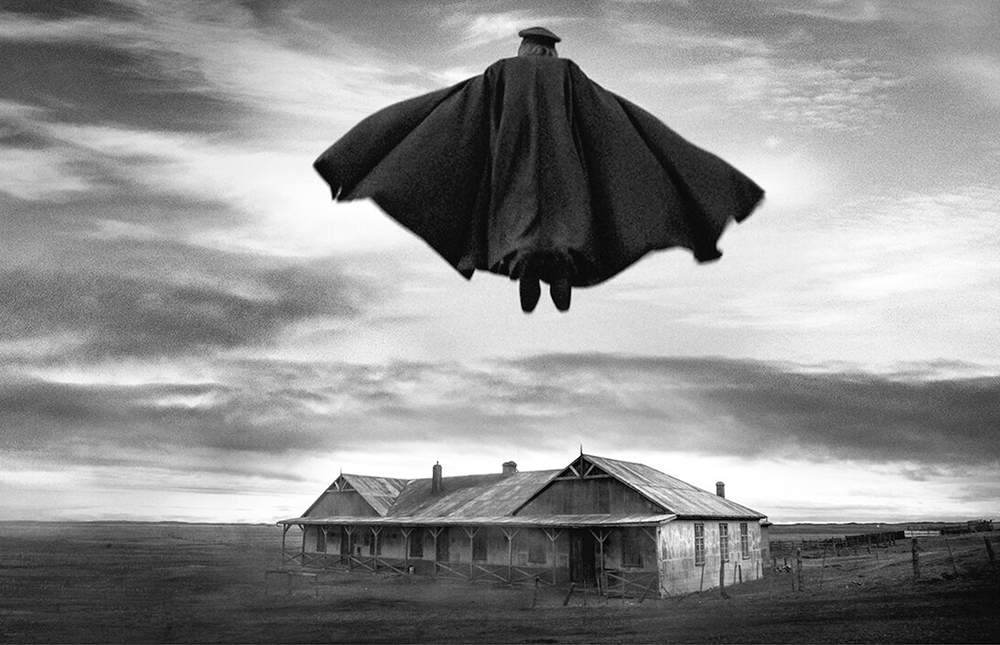If Wes Anderson had an evil twin, a twin who had his visual style but leaned toward darkness instead of light, I imagine he would make a film like “El Conde.” With its many wide shots, perfect framing, and beautiful black and white cinematography, it really feels like you’re watching a Wes Anderson film from a mirror universe, and that’s a good thing.
250 year-old vampire Augusto Pinochet (played by Jaime Vadell) wants to die. He has been a dictator most of his life, responsible for killing thousands of people, and his faithful butler Fyodor (Alfredo Castro) assisted him in holding on to power. Now, Fyodor secretly works to keep Augusto alive, despite his master’s wishes. Meanwhile, Augusto’s wife Lucia (Gloria Münchmeyer) keeps holding out hope Augusto will turn her into a vampire before he dies and Augusto’s five kids simply want him to die so they can get their inheritance. When one of the kids asks a young nun named Carmencita (Paula Luchsinger) to come to their home and exorcise Augusto, hopefully killing him in the process, things take an unexpected turn.
Cinematography and Narration Elevate ‘El Conde’
“El Conde” (directed by Pablo Larrain and written by Pablo Larrain and Guillermo Calderón) aims to be a hybrid of horror and comedy and it succeeds for the most part. The story is fairly cliché, but the film is ultimately saved and elevated by the performances of three key actors.
The film starts with an extended narration by a mysterious female (who we learn more about later in the film), who quickly runs through Augusto’s history growing up in France to the time he ends up as a ruthless dictator in Chile. This sequence is laced with some surprisingly graphic gore and violence. This may have been why the film was shot in black and white, but I would like to think that this was more of an artistic choice by Director Larrain and Cinematographer Edward Lachman. The graphic violence immediately signals that this isn’t going to be a timid film, it’s going for the throat (no pun intended).
Settling on the present, Augusto, having stopped consuming blood, is now old and frail, barely getting around with his walker, apathetic to his family and the world and determined to die. But occasionally, flashes of the cruelty and strength of his youth appear, especially with his adult children, who he detests and gladly makes it known to them.
Jamie Vadell Gives Augusto the Right Touches

Jaime Vadell gives Augusto a majestic air, even when he’s slowly and painfully crossing a room with his walker, slamming it down with each step with a barely contained fury. His best scenes are with his butler Fyodor. Fyodor seems to worship Augusto and there’s a love/hate relationship between the two that at times borders on parody, with Fyodor shedding a tear seemingly every time Augusto says a word. It’s like everything Augusto says is an inspirational call to arms. Alfredo Castro imbues Fyodor with menace. In some scenes he’s absolutely menacing and terrifying but in others he’s comically frail and emotional. It made every scene with him unpredictable, wondering what he would do next.
The most magnificent character of the film is Paula Luchsinger’s Carmencita. Her features are stunning, a fusion of young Barbra Streisand and actress Renée Jeanne Falconetti (from the classic silent film “The Passion of Joan of Arc”). She looks simultaneously innocent and world-weary, holy and transgressive, a fledgling nun who both shoulders the sins of the world, sins which fiercely temps her.
Wonderful and Captivating
Posing as an accountant helping Augusto straighten his financial records, she secretly collects evidence on Augusto’s financial crimes and plans his exorcism. Luchsinger makes Carmencita a chameleon of sorts, able to manipulate Augusto and his family by shifting her posture and reactions with each person to get what she needs. With Augusto, who is three times her age but smitten by her, she’s timid and flirty, batting her heavy eyelids and always leaning forward, lacing every word with sexual innuendo. With one of Augusto’s sons who’s arrogant and boastful, she eagerly compliments him and feeds his ego, sitting back and listening to him detail all the money he’s scammed for his father. For the other son who’s weepy and has low self-esteem, she changes to a motherly demeanor, comforting his fragile psyche and easily getting him to spill all his crimes.
Though there are scenes in the film that are terribly brutal (in the opening minutes especially), there are also scenes of incredible beauty. One scene at the climax of the film that involves a character flying is especially sublime. It’s one of the few films I’ve seen that captures how joyful and full of exhilaration a person would feel if they could fly. Eat your heart out, billion-dollar Marvel superhero films with characters swooshing and soaring all over the place. If you REALLY want to see a great flying scene, this film (which probably had a hundredth of the budget of a Marvel film) makes it totally wondrous and captivating.
Speaking of captivating, can we please get Paula Luchsinger to do 10 more films this year?
“El Conde” is now available to stream on Netflix.